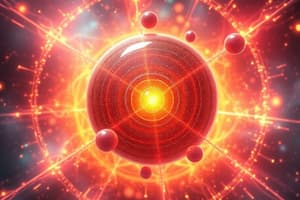Podcast
Questions and Answers
What determines the atomic number of an atom?
What determines the atomic number of an atom?
- The number of protons in the nucleus (correct)
- The number of neutrons in the nucleus
- The number of electrons surrounding the nucleus
- The positive charge of a neutron
Which statement about electrons is true?
Which statement about electrons is true?
- Electrons surround the nucleus of an atom (correct)
- Electrons are positively charged
- Electrons can have a mass similar to protons
- Electrons are found in the nucleus
What role do neutrons play in an atom?
What role do neutrons play in an atom?
- They determine the atomic number
- They cause chemical reactions in compounds
- They contribute to the atom's mass without adding charge (correct)
- They are always equal in number to protons
What is true about atoms with a full outer shell of electrons?
What is true about atoms with a full outer shell of electrons?
How does the mass of protons and neutrons compare to that of electrons?
How does the mass of protons and neutrons compare to that of electrons?
Flashcards
What are protons?
What are protons?
Positively charged particles found in the nucleus of an atom. The number of protons determines the element.
What are neutrons?
What are neutrons?
Neutral particles found in the nucleus of an atom. Different numbers of neutrons create isotopes of the same element.
What are electrons?
What are electrons?
Negatively charged particles that orbit the nucleus of an atom. They determine an atom's reactivity.
What is the atomic number?
What is the atomic number?
Signup and view all the flashcards
Why are noble gases inert?
Why are noble gases inert?
Signup and view all the flashcards
Study Notes
Subatomic Particles
- Protons have a positive charge and are located in the atom's nucleus.
- The atomic number is the count of protons in an atom's nucleus.
- Neutrons have no charge and are also found in the atom's nucleus.
- The number of neutrons determines an atom's isotope.
- Electrons have a negative charge and orbit the nucleus.
- The magnitude of a proton's positive charge equals the magnitude of an electron's negative charge.
- A neutral atom has an equal number of protons and electrons.
- Protons and neutrons are significantly heavier (approx. 2000 times) than electrons.
- The outermost electron shell can hold a maximum of eight electrons.
- Elements with full outer electron shells are inert; they do not readily react with other elements.
Studying That Suits You
Use AI to generate personalized quizzes and flashcards to suit your learning preferences.




